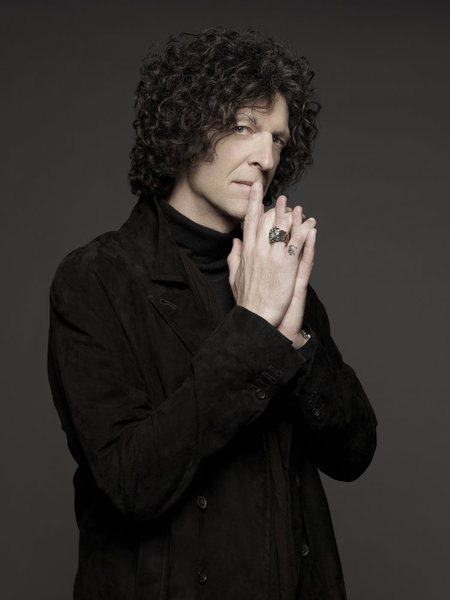Neighbor: Howard Stern

“I’m from New York, so I’m a big Howard Stern fan.”
That quote is from actor Stephen Root, of “King of the Hill” fame, but it could come from the mouth of any New Yorker. There are Howard Stern fans everywhere, but New York and Howard Stern go together like hockey and toothless Canadians. Ever since 1982, when WNBC hired him to host an afternoon slot, Howard Stern has claimed his own spot in the New York zeitgeist—smart, funny, in your face, and totally unpredictable. Riffing on current events, making prank phone calls with George Takei, or talking to strippers and dwarves, Stern has won the loyalty of millions, winning Billboard’s National syndicated Air Personality of the Year eight times. He has written two best-selling books, Private Parts and Miss America and played himself in the movie Private Parts, which raked in $41.2 million for Stern and his radio show staff. And that’s not counting international markets. He’s even run for Governor of the Empire State. While he eventually withdrew his candidacy, subsequent winner George Pataki signed “The Howard Stern Bill,” stating that construction on state roads in New York and Long Island should be limited to nighttime. For this alone, Stern has earned a place in the hearts of all New Yorkers.
When Stern announced in 2004 he would be leaving terrestrial radio within the year for Sirius satellite radio, the number of subscribers rose dramatically. His most recent media foray aired a few weeks ago, when Stern joined the panel of judges on “America’s Got Talent.” The on-line community of Stern fans enjoyed every observation as Stern commented on various acts from 7-year-old rappers to back-flipping Labradoodles. Wherever Stern goes, his fans follow.
Stern grew up on Long Island. His father, co-owner of a Manhattan recording studio, would occasionally take Stern to work with him, where he saw actors like Wally Cox, Don Adams and Larry Storch recording dialogue for cartoons.
From a very early age, Stern knew he wanted to be in radio. In 1973, at the Boston University campus radio station, Stern got his first show, playing records and reading the news. He also had a comedy show with friends called “The King Schmaltz Bagel Hour.”
After graduation, Stern worked at radio stations in Westchester and then Hartford, where he met the overnight disc jockey, Fred Norris, who would become his producer and writer for the next 30 plus years. A stint in Detroit followed, during which Stern continued to refine his on-air personality. Next, Stern went to Washington, DC’s rock station WWDC, hosting mornings. It was there that Stern first began working with Robin Quivers, who became an integral part of Stern’s “Wack Pack.” She was a former Air Force Captain with a nursing degree who had come to DC from WFBR in Baltimore. Quivers job was to read the news during Stern’s show. An enduring partnership was soon born. She was the perfect counterpart to Stern, a “voice of reason” amidst the insanity. Although Stern tripled WWDC’s morning ratings, there was constant stress with the station management. It was time for Stern to come home to New York. In1982 New Yorkers turned their dials to WNBC in the afternoons and for a lot of us, it was love. Even in a pre-Facebook, pre-tweet environment, the word got around quickly that Stern’s show was not to be missed. It only took one year for Stern to make his show the highest-rated program that WNBC had seen for the last four years. Unfortunately, it only took WNBC three years to decide that the controversial Stern was too much for management’s taste. Citing “conceptual differences,” WNBC fired Stern and Quivers in September of 1985.
Just a few months later, they were back on the air on K-Rock, WXRK, going into national syndication a year later. From Coast to Coast, Stern rocked the world of radio—he had the highest rated morning show in both New York and Los Angeles. Stern branched out into other forms of media, such as pay-per-view events like “Howard Stern’s Negligee and Underpants Party,” “The Miss Howard Stern New Year’s Eve Pageant,” and a half-hour show on E! “The Howard Stern Show,” which ran for 11 years.
Private Parts, the film version of Stern’s best-selling autobiography was released in 1997. It was a hit with fans and critics, who praised the sweet side of Stern as he chronicled his career, courtship and marriage to his first wife Alison Berns. Although their marriage would last 20 years, they separated in 1999 and divorced amicably in 2001. After a few years of bachelorhood, Stern met Beth Ostrosky at a friend’s dinner party.
She was a Pittsburgh native, who had moved to New York and established a successful modeling career, including her own line of calendars as well as numerous magazine covers. Her acting credits including appearing on G4’s show “Filter,” and Spike’s “Casino Cinema,” as well as film roles in Flirting with Disaster, and Whipped.
It didn’t take long for the self-proclaimed “King of All Media,” to fall for the beautiful, blond Ostrosky, who ranked on AskMen.com’s list of the “Most Desirable Women,” for 2007. On October 3, 2008, they were married at Le Cirque, and began a life together which included time spent year round at their Hamptons home. Stern has shared with Ostrosky his long-time relationship with Transcendental Meditation, which he began practicing during his time at Boston University, and she has involved Stern in her animal activist efforts. They are both tremendous supporters of the North Shore Animal League in Port Washington and the Wildlife Rescue Center, in Hampton Bays. Not only do the Sterns donate time and money to the Wildlife Rescue Center, but this past winter, Beth Stern, who had taken one of the center’s training classes, rescued an injured seagull, successfully transporting it back to the Wildlife Rescue Center for rehabilitation. Ten days later, the bird was ready to be released, and
husband Howard was there to shoot a video of the moment.






